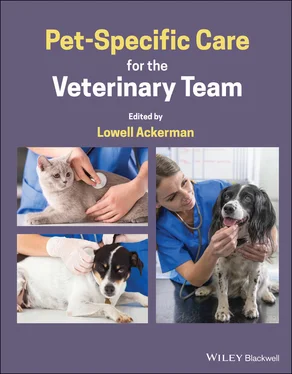Disaster planning needs to include preparation for continuity of operations. It is possible that the facility may still be useable, but local utilities may not be functioning. Plans need to be in place for communication; power, including a fuel source; refrigeration; food and water, in case local supplies are contaminated; and medications and supplies.
If the facility is not safe for use, then contact an unaffected practice to use as an alternate location until the facility can repaired, replaced, or relocated. This can help eliminate the need for your clients to seek services elsewhere and avoid a gap in animal care. Also make sure the inoperable facility is safe from further damage, such as looting or theft, and remove or secure dangerous drugs and hazardous supplies. Contact insurance carriers and be sure to video and photograph inventory and damages. Insurance coverage to have in place before a disaster occurs includes property, flood/wind/fire/earthquake as appropriate for the practice location, business interruption, professional extension, loss of income, mobile loss of income (if applicable), civil ordinance coverage, debris removal/clean‐up, building replacement with automatic inflation, workers’ compensation, and general and professional liability.
Something that many veterinarians overlook is the importance of regular practice drills. Everyone in the practice should be involved, and the drills should include everything from identifying where fire extinguishers are located to simulated evacuation. Identify where the weak spots in the plan are and correct those, so that when a true emergency occurs, the team is ready to act appropriately.
2.17.3 Pet‐Specific Advice for Clients
It is very important for the veterinary healthcare team to ensure clients are prepared for their pets in times of an emergency. Clients should have an up‐to‐date copy of medical records, including vaccinations and the names of any medications the animal may be taking. Clients will need to have crates and/or leashes and collars to safely transport their pets. It is of vital importance that each animal has permanent ID, such as a microchip, and to make sure contact information is current in a national microchip database. It is a good idea for the pet to also wear a collar with an ID tag, but these sometimes fall off or become damaged. Keep a pet first aid kit handy, containing basic supplies to clean and cover wounds, pain medication as recommended by a veterinarian, a muzzle to help limit biting if the pet is in severe distress, and any medications that the pet may take regularly. Clients should keep several days' worth of food and fresh water on hand to be used in case of shelter‐in‐place orders or when evacuation is required.
Whenever possible, it is a good idea to have knowledge of several evacuation routes ahead of time and identify pet‐friendly lodging along those routes. Sometimes clients will have to go to an emergency shelter that also allows pets. Having medical records, medications, food, and water ready to go will make the evacuation less stressful. Individuals may be less likely to evacuate if they are uncertain they can bring their pets with them, including those in abusive relationships. They may not volunteer this information to veterinary teams, so having resources available in print form and on the website may help save lives.
 EXAMPLES
EXAMPLES
XYZ Animal Care Clinic is located in Smithville, a small town by the Missouri River. Because of some strong winter storms in more northern locales, the residents of Smithville have been forewarned to expect massive flooding in the next few days. The doctors and staff at XYZ implement their disaster plan. First, all employees make sure their families, pets, and personal property are secured. Those who can return to work to prepare the clinic do so. Pet owners are called and asked to pick up their animals. Those dogs and cats that require ongoing care and cannot be discharged are transferred to a colleague's office several miles away from the expected impact zone, and the clients are notified of the transfers. The practice manager confirms that all insurance policies are current and that the medical records are backed up offsite. The practice owner secures dangerous drugs and controlled substances. The staff secure valuable equipment, such as anesthesia monitors and lab equipment, at an elevated height. Two staff members volunteer to stay overnight to monitor the situation. Supplies, such as food and bottled water, as well as a couple of sleeping bags and air mattresses, are provided. Because the clinic does not have a generator, the practice manager acquires a portable one and several tanks of extra propane to use if the clinic ends up without power following the flood event. A communication plan is put into place.
Once the flood event is over, the veterinarians and staff assess the damage. The building has minor flood damage in a couple of exam rooms and the surgical suite. The town, including the clinic, lost power for several days. XYZ Animal Care Clinic moves to the postdisaster phase of its plan. They determine that they can still see patients in the undamaged exam rooms and also create a temporary exam room in one of the doctors’ offices. Because of the generator, they are able to maintain electricity keep the lights on and the refrigerator running. The doctors arrange to use the surgical suite at a colleague's clinic one day each week to meet client needs. More urgent procedures are referred. The practice manager contacts the necessary insurance companies and immediately starts repairs to the damaged areas. XYZ is fully operational six months after the flood event.
 TAKE‐AWAYS
TAKE‐AWAYS
Make sure all doctors and staff have their personal needs taken care of – family, pets, property – so then they can focus on the veterinary practice.
Have a disaster plan for a localized event – building fire, water damage from burst pipe, etc.
Have a disaster plan for a regional event – earthquake, hurricane, massive fire, chemical spill, etc.
Keep supplies ready for evacuation, shelter‐in‐place orders, and postdisaster needs.
Maintain all necessary documents for medical records, practice management, and insurance needs.
 MISCELLANEOUS
MISCELLANEOUS
2.17.4 Cautions
Some disasters come without warning. Having a plan in place and using practice drills on a regular basis will help mitigate the effects. Identify leaders ahead of time who can stay calm and think on their feet to help the practice survive the disaster and its aftermath.
1 American Red Cross Pet Disaster Preparedness: www.redcross.org/get‐help/how‐to‐prepare‐for‐emergencies/pet‐disaster‐preparedness.html
2 AVMA Disaster Resource Center: www.avma.org/KB/Resources/Reference/disaster/Pages/default.aspx
3 AVMA Professional Liability Insurance Trust, Disaster Planning for Veterinary Practices: www.avmaplit.com/education‐center/library/disaster‐planning
Ryane E. Englar, DVM, DABVP (Canine and Feline Practice)
College of Veterinary Medicine, University of Arizona, Oro Valley, AZ, USA
Читать дальше

 EXAMPLES
EXAMPLES TAKE‐AWAYS
TAKE‐AWAYS MISCELLANEOUS
MISCELLANEOUS










